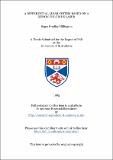Files in this item
A differential lidar system based on a xenon chloride laser
Item metadata
| dc.contributor.advisor | Maitland, Arthur | |
| dc.contributor.author | Millington, Roger Bradley | |
| dc.coverage.spatial | [ca 400]p. | en_US |
| dc.date.accessioned | 2018-06-12T08:58:30Z | |
| dc.date.available | 2018-06-12T08:58:30Z | |
| dc.date.issued | 1985-07 | |
| dc.identifier.uri | https://hdl.handle.net/10023/13927 | |
| dc.description.abstract | A differential absorption lidar (DIAL) system, based on a xenon chloride exoimer laser, has been developed and applied to measurements of atmospheric sulphur dioxide. This thesis describes the basis of the technique, the construction and operation of the prototype system, and its theoretical and practical sensitivity to sulphur dioxide concentration. The system, comprising the laser, telescope, detector and data handling equipment was developed for robustness in the field, and novel features have been included for this purpose. The Newtonian type telescope was chosen for its small image size and adequate field-of-view. It uses a "Cassegrain" type primary mirror and a visible reflector at the focus, allowing direct viewing of the scattering target. This feature is used in conjunction with direct viewing through the laser cavity, through a dielectric coated mirror, to permit laser/telescope alignment on the target. The laser itself is pumped by transverse discharge after corona/U,V pre-ionization. Laser characteristics have been measured. Those of primary importance to lidar are the energy per pulse, at 5 to 8mJ, the pulse duration of 32ns, the maximum pulse repetition rate, at 20pps, and the number of pulses to half energy, at 18000 per gas fill. The emission spectrum of the laser, with wavelengths at 307.92nm and 308.17nm, has been compared with the absorption spectrum of sulphur dioxide, showing a difference between the respective absorption coefficients. This indicated the suitability of this particular laser to the differential absorption technique. Unique selection between these wavelengths, per pulse, is desirable for optimum sensitivity in DIAU However, a novel method has been devised for modifying the relative wavelength content of one of the pulses, by inserting an absorption cell of sulphur dioxide into the laser optical cavity. The advantages of this over "distinct" wavelength selection are cheapness and robustness. However, theoretical work has shown a subsequent loss of sensitivity to atmospheric sulphur dioxide concentration, by a factor of about 5, A 3-element birefringent filter has been designed in case a more conventional tuning method is required. Specification of the detector and its operating conditions have been closely defined in order to optimise sensitivity to very low levels of backscattered light, whilst reducing the effects of unwanted background and noise. To this end, a solar-blind photomultiplier has been employed in conjunction with a narrow-band interference filter, centred around the laser emission wavelength. A relatively simple signal handling circuit was built to perform the minimum requirement of measuring the intensity of backscattered radiation. A micro-computer is used to control the circuitry in test and data acquisition modes, and to store data, allowing signal averaging and subsequent data analysis. Program algorithms for data analysis were developed from lidar and DIAL theory. A theoretical investigation of atmospheric scattering properties was carried-out to provide scatter coefficients for application in the lidar equation. The validity of the lidar equation was proved when computer-modelled oscilloscope traces of lidar return signals were found to match, closely, experimental traces of return signals from the smoke plume at Methil power station. A theoretical treatment, using the lidar equation, gave expressions for target gas concentrations as a function of return signal intensities. This was done for the case where unique wavelength pulses are transmitted into the atmosphere and was repeated for the case of "mixed wavelength" pulses, applying to the DIAL experiment. Prediction of sensitivity of the system in measuring sulphur dioxide concentration is based on the noise content of the return signals. The analysis has given a detection limit range of about 10ppm.m to 800ppm.m, for the "mixed wavelength" application and an expected range of 2ppm.m to I60ppm.ra if the laser is tuned conventionally, depending on signal strength and number of averaged pulse pairs. Errors expected in measurements of finite sulphur dioxide concentrations are given. The system was applied to measuring sulphur dioxide, emitted under control, into the path of the laser pulse. Measured peaks of about 120ppm were expected and measurements taken successively are in agreement with expected dispersal rates. Fluctuations of measured sulphur dioxide levels, about a mean, are shown to be within the theoretically-evaluated error limits. This close agreement between theory and experiment allows the theoretical detection limits to be treated as realistic. | en_US |
| dc.language.iso | en | en_US |
| dc.publisher | University of St Andrews | |
| dc.subject.lcc | TK7871.35M5 | |
| dc.subject.lcsh | Gas lasers | |
| dc.title | A differential lidar system based on a xenon chloride laser | en_US |
| dc.type | Thesis | en_US |
| dc.type.qualificationlevel | Doctoral | en_US |
| dc.type.qualificationname | PhD Doctor of Philosophy | en_US |
| dc.publisher.institution | The University of St Andrews | en_US |
This item appears in the following Collection(s)
Items in the St Andrews Research Repository are protected by copyright, with all rights reserved, unless otherwise indicated.

